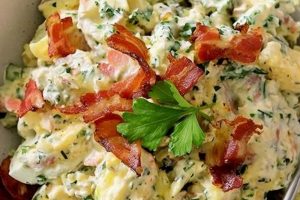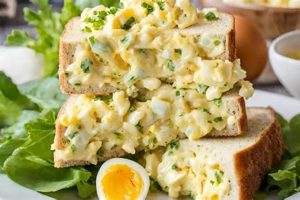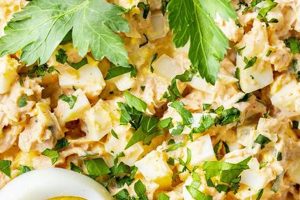Combining canned tuna with chopped hard-boiled eggs forms the foundation of a versatile and protein-rich dish. Mayonnaise typically binds the ingredients, while additions like celery, onion, relish, and seasonings create varied flavor profiles. A simple preparation might include flaked tuna, diced eggs, mayonnaise, chopped celery, salt, and pepper.
This combination offers a convenient and affordable meal option, providing substantial protein and healthy fats. Its adaptable nature allows for customization to suit individual preferences, incorporating diverse ingredients and seasonings. Historically, dishes combining readily available protein sources like canned tuna and eggs gained popularity as economical and nutritious meals, particularly during periods of economic constraint. This culinary practicality continues to contribute to their enduring appeal.
The following sections explore variations on this classic dish, offering inspiration for both traditional and innovative preparations. Recipes will encompass ingredient selection, preparation methods, and serving suggestions, providing a comprehensive guide to creating satisfying and flavorful meals featuring tuna and egg.
Tips for Exceptional Tuna and Egg Salad
Elevating tuna and egg salad beyond the ordinary involves attention to detail and thoughtful ingredient selection. These tips offer guidance for creating a superior culinary experience.
Tip 1: Quality Ingredients Matter: Opt for high-quality canned tuna packed in water or olive oil, and use fresh, farm-fresh eggs whenever possible. The foundation of the salad directly impacts the final flavor.
Tip 2: Mindful Egg Preparation: Properly cooked eggs, neither undercooked nor overcooked, contribute optimal texture. Achieve this by bringing eggs to a boil, then removing from heat and allowing them to sit covered in hot water for the desired doneness.
Tip 3: Texture Enhancement: Finely chopping celery and red onion adds a satisfying crunch, while incorporating ingredients like chopped pickles or water chestnuts introduces textural complexity.
Tip 4: Flavor Exploration: Experiment with fresh herbs such as dill, chives, or parsley. A dash of Dijon mustard or a squeeze of lemon juice can brighten the flavor profile.
Tip 5: Mayonnaise Mastery: While mayonnaise is traditional, consider using Greek yogurt or avocado for a healthier, lighter alternative. Start with a small amount and add more as needed to achieve the desired consistency.
Tip 6: Seasoning Strategies: Freshly ground black pepper, sea salt, and paprika enhance the inherent flavors of the tuna and egg. A pinch of cayenne pepper adds a subtle kick.
Tip 7: Chill Out: Allowing the salad to chill in the refrigerator for at least 30 minutes allows the flavors to meld and enhances the overall experience.
By following these guidelines, one can achieve a tuna and egg salad that is both flavorful and satisfying. Attention to these details elevates the dish from simple fare to a truly enjoyable culinary creation.
These practical tips provide a foundation for culinary exploration. The following section offers specific recipe variations to inspire creativity in the kitchen.
1. High-quality Tuna
High-quality tuna plays a crucial role in tuna salad recipes incorporating eggs. The tuna’s inherent flavor and texture significantly influence the final dish, impacting overall palatability and satisfaction. Understanding the nuances of tuna selection is essential for creating a superior culinary experience.
- Species Selection:
Different tuna species offer distinct flavor profiles and textures. Albacore, known for its delicate flavor and firm texture, often commands a premium price. Yellowfin, with its slightly stronger flavor, presents a versatile and readily available option. Skipjack, a more economical choice, possesses a bolder flavor suitable for those who prefer a more pronounced taste. Species selection directly impacts the final character of the salad.
- Packing Method:
Tuna packed in water offers a cleaner flavor profile, allowing the inherent taste of the fish to shine. Oil-packed tuna, particularly those packed in olive oil, provides a richer, more luxurious mouthfeel. The packing liquid also contributes to the salad’s moisture content, influencing the final texture. Draining excess liquid, regardless of the packing method, helps control the salad’s consistency.
- Sustainability Considerations:
Choosing sustainably sourced tuna supports responsible fishing practices and helps protect marine ecosystems. Look for certifications like the Marine Stewardship Council (MSC) label, which indicates that the tuna comes from a well-managed fishery. Sustainable choices contribute to long-term ocean health and responsible consumption.
- Freshness Indicators:
When purchasing canned tuna, check for dents or bulges in the can, which could indicate spoilage. Upon opening, the tuna should appear firm and have a fresh aroma. Discarding any tuna with an off odor is crucial for food safety. Freshness directly impacts the flavor and overall enjoyment of the salad.
By considering these facets of tuna selection, one can elevate a simple tuna and egg salad to a truly exceptional culinary creation. The tuna’s quality establishes the foundation upon which other ingredients build, contributing significantly to the final dish’s overall appeal and satisfaction.
2. Perfectly Cooked Eggs
The role of perfectly cooked eggs within tuna salad extends beyond mere ingredient status; it directly impacts the texture, flavor, and overall aesthetic appeal of the final dish. Overcooked eggs, characterized by a rubbery texture and chalky yolk, detract from the desired creamy consistency. Conversely, undercooked eggs present food safety concerns and introduce an undesirable runny texture. The ideal egg exhibits a firm, yet yielding white and a fully cooked, yet moist yolk, contributing a velvety texture that complements the flaked tuna.
Achieving this optimal state requires precise cooking techniques. A common method involves gently boiling eggs for a specific duration, followed by an ice bath to halt the cooking process. The duration of the boil influences the yolk’s consistency, ranging from a slightly soft center to a fully firm yolk. This control allows for customization based on individual preferences. For example, a seven-minute boil typically yields a yolk with a soft, creamy center, while a ten-minute boil results in a fully firm yolk. The chosen cooking method impacts the egg’s integration within the salad, influencing how it binds with other ingredients.
The impact of egg doneness extends beyond texture. A perfectly cooked egg contributes a subtle richness and depth of flavor, enhancing the overall complexity of the tuna salad. Overcooked eggs often develop a slightly sulfurous odor, negatively affecting the final dish. Achieving the ideal cook ensures the egg enhances, rather than detracts from, the intended flavor profile. Mastery of egg cookery, therefore, becomes a critical component in crafting exceptional tuna salad. It represents the difference between a simple mixture and a carefully constructed culinary creation.
3. Complementary Ingredients
Complementary ingredients transform tuna salad with egg from a simple protein combination into a complex and flavorful dish. These additions contribute texture, enhance existing flavors, and introduce new dimensions to the overall culinary experience. Strategic ingredient selection is essential for crafting a well-balanced and satisfying salad.
- Textural Elements:
Ingredients like celery, red onion, and chopped pickles introduce crucial textural contrast to the softness of the tuna and egg. The crispness of celery, the sharp bite of red onion, and the tangy crunch of pickles prevent the salad from becoming monotonous. Water chestnuts offer a unique, subtly sweet crunch. These textural variations elevate the eating experience.
- Flavor Enhancers:
Fresh herbs, such as dill, parsley, chives, and tarragon, introduce aromatic complexity. Dill’s bright, slightly tangy flavor complements the richness of the tuna, while parsley adds a fresh, herbaceous note. Chives offer a delicate onion flavor, and tarragon contributes a subtle anise-like essence. These additions elevate the salad beyond basic seasonings.
- Umami Boosters:
Capers, olives, and a touch of Dijon mustard introduce umami, a savory, fifth taste that deepens the flavor profile. Capers provide a briny, salty burst, while olives offer a rich, fruity, and slightly bitter counterpoint. Dijon mustard contributes a tangy complexity. These ingredients create a more nuanced and sophisticated flavor experience.
- Balancing Acidity:
A squeeze of lemon juice or a splash of apple cider vinegar balances the richness of the mayonnaise and tuna, adding brightness and preventing the salad from feeling heavy. The acidity also helps to preserve the salad’s freshness. This careful balance of flavors ensures a more harmonious final product.
The interplay of these complementary ingredients elevates tuna salad with egg from a basic combination to a nuanced culinary creation. Consideration of texture, flavor enhancement, umami boosters, and balancing acidity ensures a well-rounded and satisfying sensory experience.
4. Flavorful Seasonings
Flavorful seasonings represent a critical component in elevating tuna salad with egg beyond a basic combination of ingredients. Careful seasoning enhances the inherent flavors of the tuna and egg, while also adding depth and complexity. The judicious use of seasonings can transform a simple salad into a culinary delight.
- Classic Combinations:
Salt and freshly ground black pepper provide the foundational seasoning for most tuna salads. These staples enhance the natural flavors of the tuna and egg, providing a balanced base upon which other seasonings can build. A pinch of paprika adds a subtle smokiness and warm color.
- Herbaceous Accents:
Dried or fresh herbs introduce aromatic complexity. Dill, parsley, chives, and tarragon complement the flavors of tuna and egg. Dried dill offers a concentrated, slightly tangy flavor, while fresh parsley provides a bright, herbaceous note. The choice between dried and fresh herbs depends on the desired intensity and overall flavor profile.
- Zesty Additions:
A dash of cayenne pepper introduces a subtle heat, while a pinch of dry mustard adds a pungent depth. These additions awaken the palate and provide a counterpoint to the richness of the mayonnaise or other binder. Lemon zest offers a bright citrus aroma and flavor.
- Balancing Influences:
A touch of sweetness, such as a pinch of sugar or a drop of honey, balances the savory elements and enhances the overall flavor profile. This subtle sweetness rounds out the other seasonings, creating a more harmonious blend.
The interplay of these seasonings transforms tuna salad with egg from a simple dish into a more nuanced and satisfying culinary creation. The careful balance of salt, pepper, herbs, spices, and other flavor enhancers elevates the overall experience, demonstrating the significant impact of thoughtful seasoning.
5. Appropriate Binder
The binder in tuna salad with egg performs the crucial function of unifying the individual components into a cohesive whole. It contributes to the salad’s overall texture, moisture content, and flavor profile. Selecting an appropriate binder is essential for achieving the desired consistency and palatability.
- Classic Mayonnaise:
Mayonnaise represents the traditional binder for tuna salad, offering a creamy texture and rich flavor. Its emulsification properties effectively bind the tuna, egg, and other ingredients, creating a smooth and homogenous mixture. Variations in mayonnaise quality and fat content influence the final salad’s richness and overall mouthfeel. For example, using a light mayonnaise results in a lighter, less calorie-dense salad, while a full-fat mayonnaise contributes a more traditional, richer texture.
- Healthier Alternatives:
Greek yogurt provides a lighter, tangier alternative to mayonnaise. Its lower fat content and higher protein content appeal to health-conscious individuals. Similarly, mashed avocado offers a creamy, subtly flavored binder rich in healthy fats. These alternatives contribute unique flavor profiles and nutritional benefits. For instance, Greek yogurt introduces a tangy note that complements the savory elements of the salad, while avocado adds a creamy richness and healthy fats.
- Flavorful Enhancements:
Pureeing roasted red peppers or incorporating aioli, a garlic-infused mayonnaise, adds depth and complexity to the binder. These additions infuse the salad with distinct flavors, transforming it from a simple combination into a more sophisticated culinary creation. The roasted red peppers introduce a smoky sweetness, while the aioli adds a pungent garlic note.
- Binder Quantity:
The amount of binder used significantly impacts the final salad’s consistency. Too much binder creates a loose, sloppy mixture, while too little results in a dry, crumbly texture. Achieving the ideal balance ensures the salad holds its shape yet remains moist and palatable. Starting with a smaller quantity and gradually adding more allows for precise control over the final consistency.
The choice of binder significantly impacts the overall sensory experience of tuna salad with egg. Careful consideration of texture, flavor, and dietary preferences allows for the selection of the most appropriate binder, transforming individual ingredients into a harmonious and satisfying culinary creation. The binder is not merely a functional component; it plays a defining role in the final dish’s character.
6. Proper Chilling
Proper chilling is integral to the overall quality and safety of tuna salad with egg. Chilling affects both flavor development and food safety, making it a crucial step that should not be overlooked. Lowering the temperature slows bacterial growth, a critical factor in preventing foodborne illnesses, particularly given the perishable nature of the ingredients. Additionally, chilling allows the flavors of the various componentstuna, egg, seasonings, and binderto meld and harmonize, creating a more cohesive and balanced flavor profile. Without adequate chilling, the individual flavors remain distinct, and the overall taste experience suffers. For instance, a freshly made tuna salad might taste predominantly of mayonnaise, with the other flavors muted. After proper chilling, however, the flavors of the tuna, egg, and seasonings emerge, creating a more complex and enjoyable taste.
The practical significance of this understanding lies in the improved quality and safety of the final product. Chilling for a sufficient duration, ideally at least 30 minutes, but preferably longer, noticeably enhances the salad’s flavor. The flavors become more integrated and balanced, resulting in a more satisfying sensory experience. Furthermore, proper chilling significantly reduces the risk of bacterial proliferation, safeguarding against potential foodborne illnesses. This is particularly important for vulnerable populations, such as pregnant women, young children, and the elderly. Practical application involves transferring the prepared tuna salad to an airtight container and refrigerating it promptly. Maintaining a refrigerator temperature of 40F (4C) or below further ensures food safety.
In summary, proper chilling is not merely a suggestion but a critical step in preparing tuna salad with egg. It contributes significantly to both flavor development and food safety. By understanding the impact of temperature on flavor and bacterial growth, individuals can create a higher-quality, safer, and more enjoyable culinary experience. Neglecting this step compromises both the taste and safety of the dish, underscoring the importance of proper chilling in the preparation of tuna salad with egg.
Frequently Asked Questions
This section addresses common inquiries regarding the preparation and consumption of tuna salad with egg, offering practical guidance and clarifying potential misconceptions.
Question 1: How long can tuna salad with egg be safely stored in the refrigerator?
Properly stored tuna salad with egg should be consumed within three to five days to minimize the risk of bacterial growth.
Question 2: Can tuna salad with egg be frozen?
Freezing is not recommended, as it negatively impacts the texture of both the tuna and egg, resulting in a watery consistency upon thawing.
Question 3: What are common signs of spoilage in tuna salad with egg?
Indicators of spoilage include a sour odor, discoloration, or the presence of mold. If any of these signs are present, the salad should be discarded immediately.
Question 4: How can the nutritional value of tuna salad with egg be maximized?
Using tuna packed in water, incorporating plenty of fresh vegetables, and opting for a lower-fat binder like Greek yogurt or avocado enhance the nutritional profile.
Question 5: What are suitable bread or cracker options for serving tuna salad with egg?
Tuna salad with egg pairs well with a variety of breads and crackers, including whole-wheat bread, croissants, rye bread, and multigrain crackers. The choice depends on individual preferences and dietary considerations.
Question 6: Can tuna salad with egg be served as part of a larger meal?
It can serve as a sandwich filling, a component within a larger salad, or a topping for lettuce wraps. Its versatility allows for incorporation into diverse meal structures.
Understanding these key aspects of preparation, storage, and consumption ensures both a safe and enjoyable culinary experience.
Beyond these frequently asked questions, further exploration of tuna salad variations and serving suggestions follows.
Conclusion
Exploration of tuna salad incorporating eggs reveals a dish offering both simplicity and culinary depth. Careful ingredient selection, from the tuna itself to complementary vegetables and seasonings, significantly impacts the final product. Understanding the role of each componentthe binder, the seasonings, and even the chilling processallows for a nuanced approach, transforming a basic combination into a satisfying meal. Consideration of textural interplay, flavor balancing, and food safety principles elevates this dish beyond mere sustenance.
Culinary experimentation within established frameworks encourages personalized variations, reflecting individual preferences and dietary needs. The adaptable nature of this classic combination ensures its continued relevance in a diverse culinary landscape. Further exploration of flavor profiles and creative presentation offers a pathway to continuous culinary discovery within the seemingly simple realm of tuna salad enhanced by the richness of eggs.






